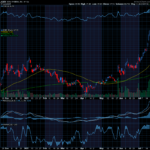by Dan Keen
Some optionable stocks, but not all, have expiration dates that go out one or two years. These option series are called “LEAPS”, which is an acronym for Long-term Equity AnticiPation Securities. First introduced in 1990, these long-dated option contracts can go out as long as 39 months, and they always expire in the month of January.
For the option buyer, LEAPS offer many benefits. Because the option exists for such a long time, the premiums for LEAPS are much higher than for short-term options. And as is true for all option buyers, there is less money tied up in buying an option than buying the actual stock. Furthermore, since LEAPS have a low decay rate during their first few months, option buyers can use LEAPS instead of short-term options for short-term plays.
The price erosion of LEAPS due to time decay is not linear; the price does not decay at an equal rate per unit of time. During the first few months of a LEAP, time erosion has a minimal negative effect on the option price. So, option buyers can purchase a LEAP on a stock that they anticipate will make a move within the next two or three months, while suffering a minimal price decrease on their option. The chart below shows the behavior of an option premium price over time. There is little decay during the first few months, and accelerated decay during the last months.

As option sellers, LEAPS are not as attractive for covered call plays. In favor of writing covered LEAPS is, obviously, the large premium that is paid. In March of 1999 we purchased a LEAP on Compaq Computer (CPQ), with an expiration date of January 2000. We received an $8.50 premium. That’s a big premium! Our intention was to hold on to the stock long term, so making an extra $850 (we had 100 shares of the stock), and having that money in our account on the next day worked out well. That cash was then put to work buying another stock and doing another covered call play.

The story doesn’t end there. Compaq later dropped significantly in price, and we were able to buy back our call at a very low price (about $3.50/share), pocketing the difference of $475.00 and freeing up our stock. We believed the stock would eventually recover, so we kept the stock. Then we began writing covered calls with lower strike prices each month for several months, as the stock price slowly rose to its previous level. Covered calls are a great way to generate income!
NO doubt you have already realized the main drawback to writing a covered LEAP is the very long time we are obligated to hold the stock. For that reason, we seldom write covered LEAPS, having enjoyed much success writing calls with expiration dates only one or two months out. For those of us who sometimes lack patience (which is a bad personality trait for traders), writing covered LAPS takes away some of the fun of trading on a more frequent basis.










Recent Comments